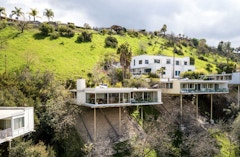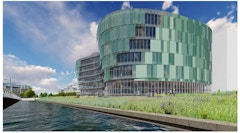
145 results
-
 This case study provides an overview of building hybrid curtain wall system and future opportunities for the use of timber. It will also review the…
This case study provides an overview of building hybrid curtain wall system and future opportunities for the use of timber. It will also review the… -
Mapping Advanced Facades
- Paper by David Russell Lehrer · Vito Lamberti
This paper describes the development of an interactive map that highlights case studies of advanced facade design strategies and technologies from
-

Heat-actuated Auxetic Facades
- Paper by Amira Abdel-Rahman · Elnaz Tafrihi
Highly transformable materials can be used as adaptive exterior shading systems by leveraging the relationship between external stimuli (heat) and
-

Multi Layer Facades
- Paper by Robert Moisy
The history of high performance facades and glazing has been a tale of attempting to manage the conflicting requirements of, on one hand inviting
-
Orbit Tower
- Paper by Enrica Oliva · Michele Andaloro · Werner Sobek
While most of high-rise buildings feature a core surrounded by a spatial frame defining the volume, one could envision a column-free plan where the
-
Translation from Concept to Construction
- Paper by Ryan Donaghy, AIA · Matthew Spahr, PE
Fidelity between the built enclosure and early visualizations is rarely, if ever, an accident. When achieved, it comes as the result of persistent
-
Glass in GSA Buildings
- Paper by Georgia Scalfano
Embodied carbon in buildings is a key factor in building decarbonization and while it is generally small compared to operational carbon, the
-

U-Factor Matters in Hot Climates
- Paper by Helen Sanders, PhD
It is commonly thought that fenestration U-factor is not a key determinant in the performance of facades in hot climates, and generally the focus of
-

Establishing a Life Cycle Assessment Methodology for Innovative Facade
- Paper by Vikki Lew
Life cycle assessment was introduced in the 1970s as an analytical tool to quantify the environmental impact of a product, process, or service.
-

The Monash Woodside Building
- Paper by Alberto Sangiorgio · Andrew Cortese · Walter van der Linde
Today’s environmental challenges highlight the necessity of a holistic approach to façade design and construction, key to achieve the ambitious 2030
-

EUI of Building Clusters
- Paper by Srinivas M. Rao, AIA, AICP, LEED AP
Large master planned developments such as Battery Park City in Manhattan, Mission Bay in San Francisco, and Playa Vista in Los Angeles were built
-
Edge Lighting Glazing with Hidden Fixtures
- Paper by Dave McCarroll · Dan Weinreber · Lei Fu
Dynamic architectural lighting in urban areas is a key element in creating attractive nighttime icons in addition to potentially generating
-

Direct Sun and Occupant Comfort
- Paper by Madeline Gradillas, Henry Richardson,
Direct sun on the body is a known potential cause of thermal discomfort for occupants, yet most thermal comfort simulations do not capture its… -
DC Water Headquarters Case Study
- Paper by Sven Shockey · Leland Curtis · David Fersh
Facades must be responsive to a myriad of qualities and influences ranging from urban impact and aesthetic character to numerous performance
-

ETFE Membrane Envelope Strategies
- Paper by Audrey L Worden, ISSF, Principal + Founding Partner Kihong R. Ku, DDes, Associate Professor, Design Technology and Architectural Innovation, Adaptive Envelopes Alexander G. Worden, RA NCARB, Principal + Founding Partner
Airflow within the cavity of double-skin facades is a key component of adaptive building envelopes which change thermophysical properties to meet… -

Paul Rudolph's Christian Science Building
- Paper by Scott Murray,
This paper presents new historical research on the concrete facade of an important but relatively unknown and now demolished building by the American… -

The Myth of Simplicity
- Paper by Gerry Lang
There were good why reasons early US Modernism first evolved in California– wide open sites with no constraints (physical or zoning), and effectively
-

Determining the Optimal Opening for Multi Skin Facade with External Ventilation
- Paper by Peter Simmonds,
The envelope of the Harbin Bank Building in Beijing has a Multi-Skin Facade where the outer cavity is naturally ventilated. During the design the… -
Delivering Beauty
- Paper by Michael Mulhern
Amidst the critical conversations about the need to build better and more efficient building skins, designers are also mindful of the need for the
-

Performance of Compact, Closed Cavity, Double-skin Curtain Wall
- Paper by Julien Schwartz, M. Eng. · Katie Hay, P. Eng. · Stéphane Hoffman, M. Arch., M. Eng, PE
A proposed design for a compact, closed cavity, double-skin curtain wall system in the Marine climate of the West Coast raises questions of potential



